Education Management: Impact of Motivation on Individuals in Schools
VerifiedAdded on 2021/06/17
|10
|3528
|20
Essay
AI Summary
This essay delves into the concept of motivation within the context of education management, emphasizing its significance for individuals in schools. It highlights the increasing competitiveness in the modern world and the crucial role motivation plays in preparing individuals for future challenges. The essay explores how education equips children with knowledge, skills, and tools to tackle life's problems, referencing the views of T.H. White and Martin Luther King Jr. It addresses the growing stress levels among students due to increasing coursework and the dynamic nature of the educational field. The essay defines motivation as a process for encouraging individuals to achieve goals and discusses prominent theories like Maslow's hierarchy of needs and Herzberg's two-factor theory. It examines how educational institutions utilize these concepts to motivate students and teachers, fostering growth and development while addressing issues of de-motivation and academic performance. The importance of self-actualization and the practical application of motivational strategies in enhancing educational outcomes are also emphasized.
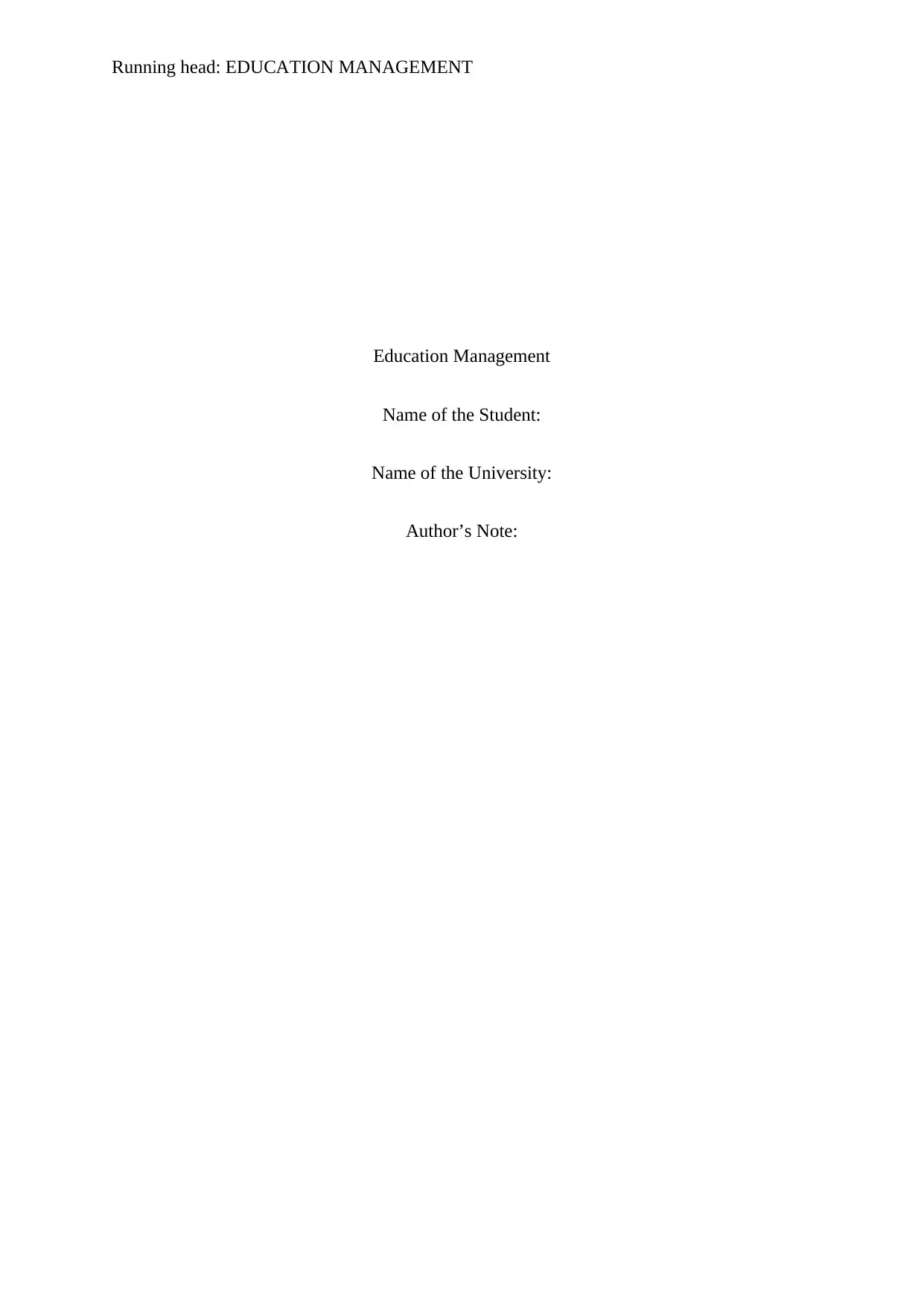
Running head: EDUCATION MANAGEMENT
Education Management
Name of the Student:
Name of the University:
Author’s Note:
Education Management
Name of the Student:
Name of the University:
Author’s Note:
Paraphrase This Document
Need a fresh take? Get an instant paraphrase of this document with our AI Paraphraser
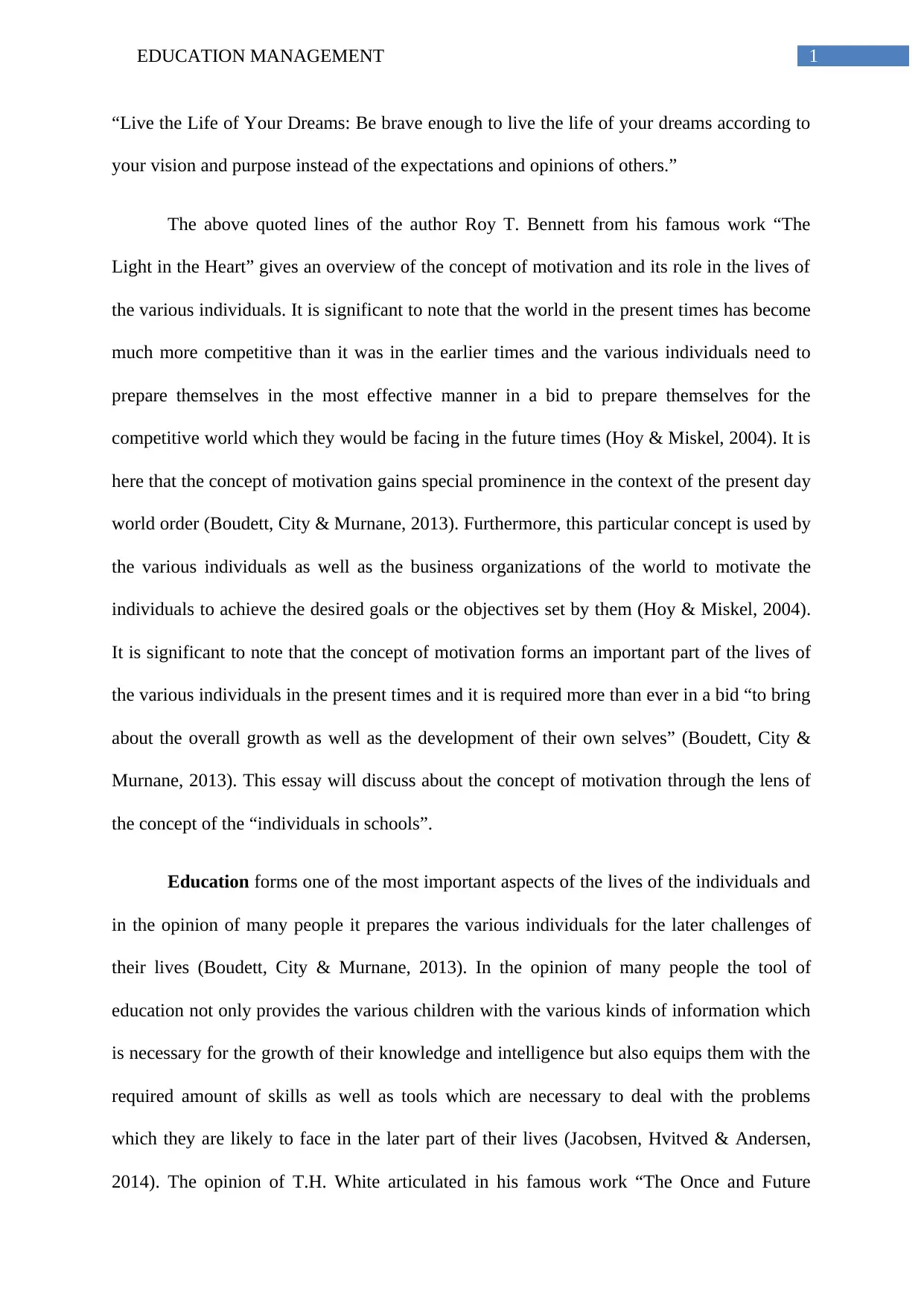
1EDUCATION MANAGEMENT
“Live the Life of Your Dreams: Be brave enough to live the life of your dreams according to
your vision and purpose instead of the expectations and opinions of others.”
The above quoted lines of the author Roy T. Bennett from his famous work “The
Light in the Heart” gives an overview of the concept of motivation and its role in the lives of
the various individuals. It is significant to note that the world in the present times has become
much more competitive than it was in the earlier times and the various individuals need to
prepare themselves in the most effective manner in a bid to prepare themselves for the
competitive world which they would be facing in the future times (Hoy & Miskel, 2004). It is
here that the concept of motivation gains special prominence in the context of the present day
world order (Boudett, City & Murnane, 2013). Furthermore, this particular concept is used by
the various individuals as well as the business organizations of the world to motivate the
individuals to achieve the desired goals or the objectives set by them (Hoy & Miskel, 2004).
It is significant to note that the concept of motivation forms an important part of the lives of
the various individuals in the present times and it is required more than ever in a bid “to bring
about the overall growth as well as the development of their own selves” (Boudett, City &
Murnane, 2013). This essay will discuss about the concept of motivation through the lens of
the concept of the “individuals in schools”.
Education forms one of the most important aspects of the lives of the individuals and
in the opinion of many people it prepares the various individuals for the later challenges of
their lives (Boudett, City & Murnane, 2013). In the opinion of many people the tool of
education not only provides the various children with the various kinds of information which
is necessary for the growth of their knowledge and intelligence but also equips them with the
required amount of skills as well as tools which are necessary to deal with the problems
which they are likely to face in the later part of their lives (Jacobsen, Hvitved & Andersen,
2014). The opinion of T.H. White articulated in his famous work “The Once and Future
“Live the Life of Your Dreams: Be brave enough to live the life of your dreams according to
your vision and purpose instead of the expectations and opinions of others.”
The above quoted lines of the author Roy T. Bennett from his famous work “The
Light in the Heart” gives an overview of the concept of motivation and its role in the lives of
the various individuals. It is significant to note that the world in the present times has become
much more competitive than it was in the earlier times and the various individuals need to
prepare themselves in the most effective manner in a bid to prepare themselves for the
competitive world which they would be facing in the future times (Hoy & Miskel, 2004). It is
here that the concept of motivation gains special prominence in the context of the present day
world order (Boudett, City & Murnane, 2013). Furthermore, this particular concept is used by
the various individuals as well as the business organizations of the world to motivate the
individuals to achieve the desired goals or the objectives set by them (Hoy & Miskel, 2004).
It is significant to note that the concept of motivation forms an important part of the lives of
the various individuals in the present times and it is required more than ever in a bid “to bring
about the overall growth as well as the development of their own selves” (Boudett, City &
Murnane, 2013). This essay will discuss about the concept of motivation through the lens of
the concept of the “individuals in schools”.
Education forms one of the most important aspects of the lives of the individuals and
in the opinion of many people it prepares the various individuals for the later challenges of
their lives (Boudett, City & Murnane, 2013). In the opinion of many people the tool of
education not only provides the various children with the various kinds of information which
is necessary for the growth of their knowledge and intelligence but also equips them with the
required amount of skills as well as tools which are necessary to deal with the problems
which they are likely to face in the later part of their lives (Jacobsen, Hvitved & Andersen,
2014). The opinion of T.H. White articulated in his famous work “The Once and Future
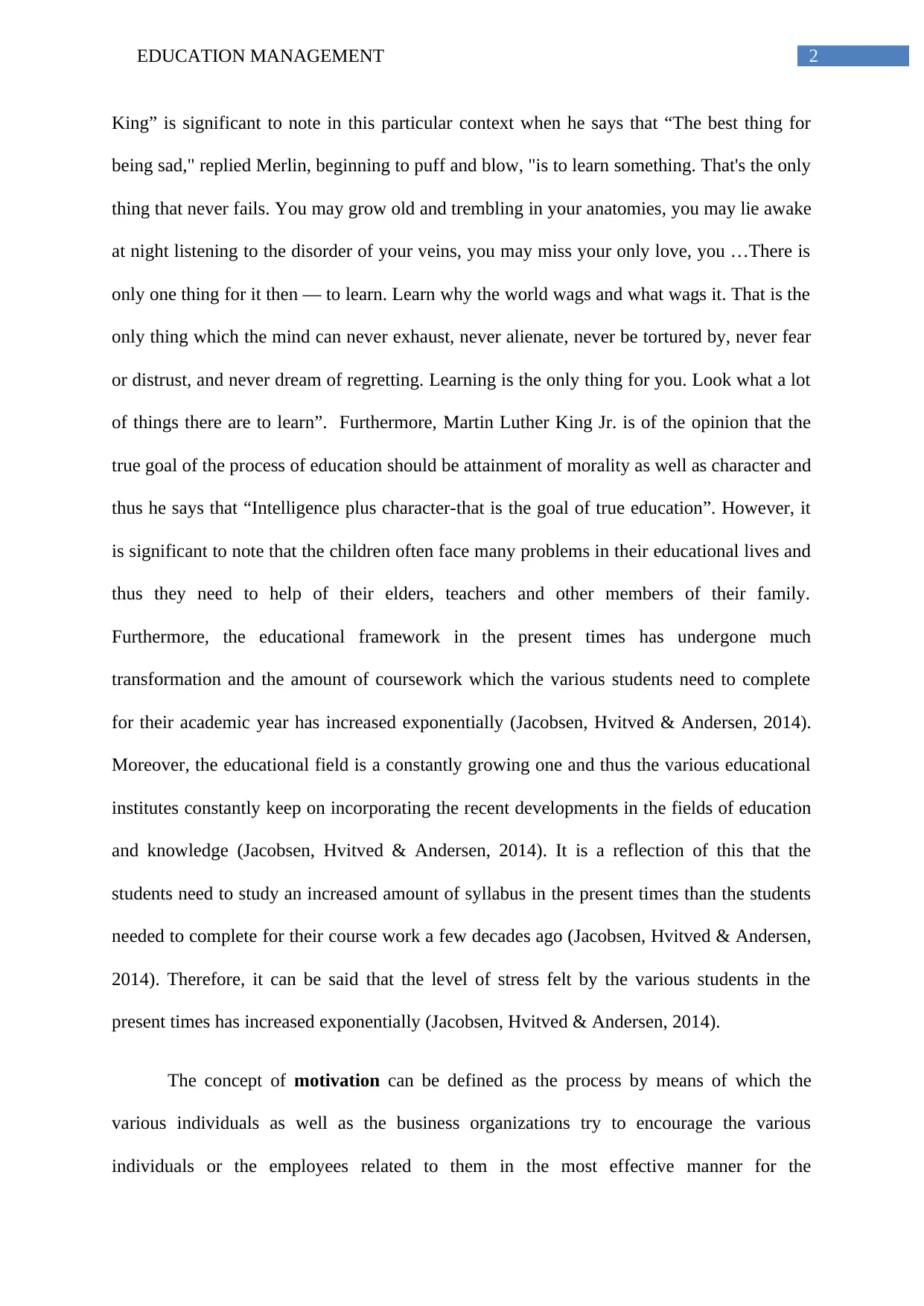
2EDUCATION MANAGEMENT
King” is significant to note in this particular context when he says that “The best thing for
being sad," replied Merlin, beginning to puff and blow, "is to learn something. That's the only
thing that never fails. You may grow old and trembling in your anatomies, you may lie awake
at night listening to the disorder of your veins, you may miss your only love, you …There is
only one thing for it then — to learn. Learn why the world wags and what wags it. That is the
only thing which the mind can never exhaust, never alienate, never be tortured by, never fear
or distrust, and never dream of regretting. Learning is the only thing for you. Look what a lot
of things there are to learn”. Furthermore, Martin Luther King Jr. is of the opinion that the
true goal of the process of education should be attainment of morality as well as character and
thus he says that “Intelligence plus character-that is the goal of true education”. However, it
is significant to note that the children often face many problems in their educational lives and
thus they need to help of their elders, teachers and other members of their family.
Furthermore, the educational framework in the present times has undergone much
transformation and the amount of coursework which the various students need to complete
for their academic year has increased exponentially (Jacobsen, Hvitved & Andersen, 2014).
Moreover, the educational field is a constantly growing one and thus the various educational
institutes constantly keep on incorporating the recent developments in the fields of education
and knowledge (Jacobsen, Hvitved & Andersen, 2014). It is a reflection of this that the
students need to study an increased amount of syllabus in the present times than the students
needed to complete for their course work a few decades ago (Jacobsen, Hvitved & Andersen,
2014). Therefore, it can be said that the level of stress felt by the various students in the
present times has increased exponentially (Jacobsen, Hvitved & Andersen, 2014).
The concept of motivation can be defined as the process by means of which the
various individuals as well as the business organizations try to encourage the various
individuals or the employees related to them in the most effective manner for the
King” is significant to note in this particular context when he says that “The best thing for
being sad," replied Merlin, beginning to puff and blow, "is to learn something. That's the only
thing that never fails. You may grow old and trembling in your anatomies, you may lie awake
at night listening to the disorder of your veins, you may miss your only love, you …There is
only one thing for it then — to learn. Learn why the world wags and what wags it. That is the
only thing which the mind can never exhaust, never alienate, never be tortured by, never fear
or distrust, and never dream of regretting. Learning is the only thing for you. Look what a lot
of things there are to learn”. Furthermore, Martin Luther King Jr. is of the opinion that the
true goal of the process of education should be attainment of morality as well as character and
thus he says that “Intelligence plus character-that is the goal of true education”. However, it
is significant to note that the children often face many problems in their educational lives and
thus they need to help of their elders, teachers and other members of their family.
Furthermore, the educational framework in the present times has undergone much
transformation and the amount of coursework which the various students need to complete
for their academic year has increased exponentially (Jacobsen, Hvitved & Andersen, 2014).
Moreover, the educational field is a constantly growing one and thus the various educational
institutes constantly keep on incorporating the recent developments in the fields of education
and knowledge (Jacobsen, Hvitved & Andersen, 2014). It is a reflection of this that the
students need to study an increased amount of syllabus in the present times than the students
needed to complete for their course work a few decades ago (Jacobsen, Hvitved & Andersen,
2014). Therefore, it can be said that the level of stress felt by the various students in the
present times has increased exponentially (Jacobsen, Hvitved & Andersen, 2014).
The concept of motivation can be defined as the process by means of which the
various individuals as well as the business organizations try to encourage the various
individuals or the employees related to them in the most effective manner for the
⊘ This is a preview!⊘
Do you want full access?
Subscribe today to unlock all pages.

Trusted by 1+ million students worldwide
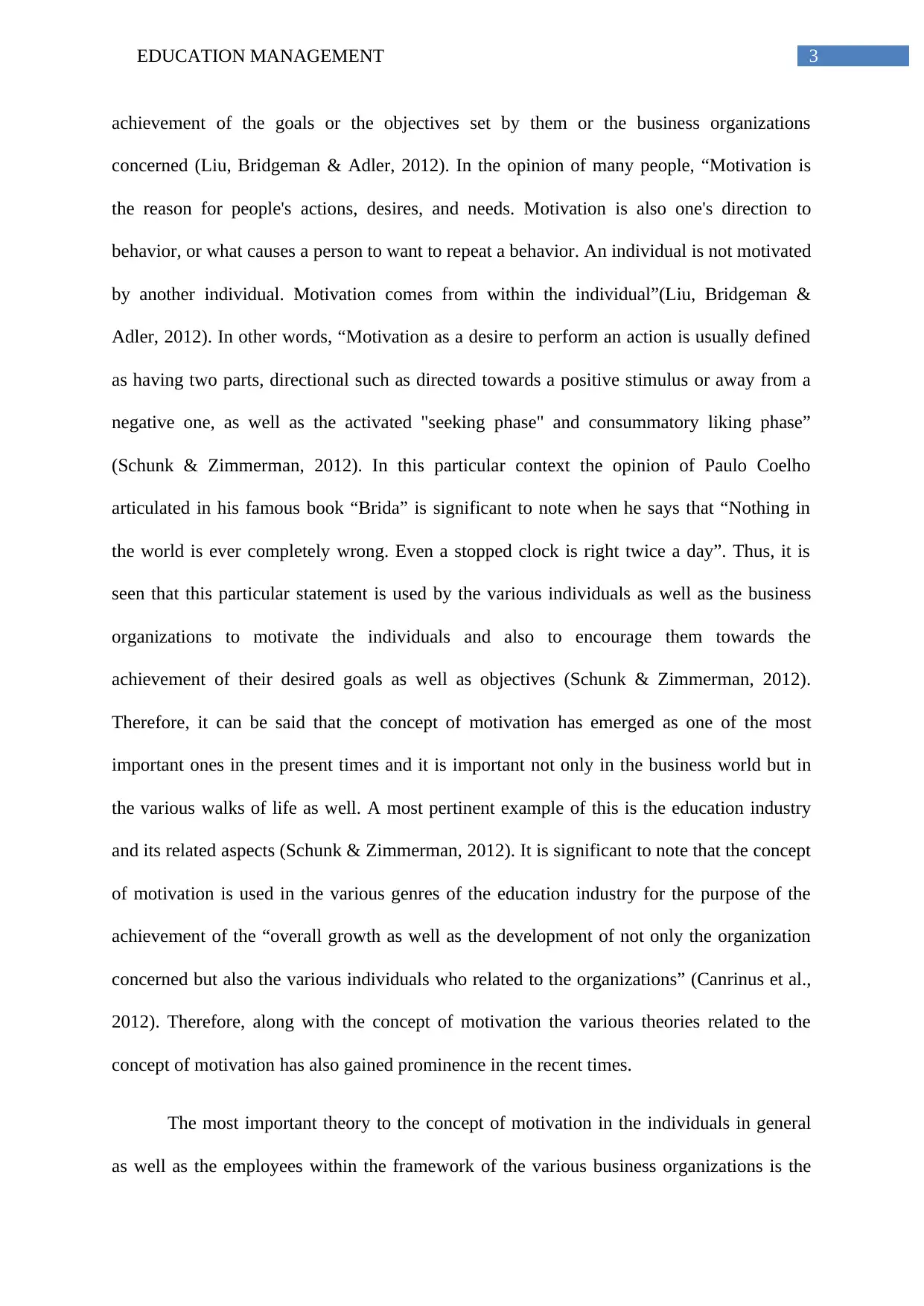
3EDUCATION MANAGEMENT
achievement of the goals or the objectives set by them or the business organizations
concerned (Liu, Bridgeman & Adler, 2012). In the opinion of many people, “Motivation is
the reason for people's actions, desires, and needs. Motivation is also one's direction to
behavior, or what causes a person to want to repeat a behavior. An individual is not motivated
by another individual. Motivation comes from within the individual”(Liu, Bridgeman &
Adler, 2012). In other words, “Motivation as a desire to perform an action is usually defined
as having two parts, directional such as directed towards a positive stimulus or away from a
negative one, as well as the activated "seeking phase" and consummatory liking phase”
(Schunk & Zimmerman, 2012). In this particular context the opinion of Paulo Coelho
articulated in his famous book “Brida” is significant to note when he says that “Nothing in
the world is ever completely wrong. Even a stopped clock is right twice a day”. Thus, it is
seen that this particular statement is used by the various individuals as well as the business
organizations to motivate the individuals and also to encourage them towards the
achievement of their desired goals as well as objectives (Schunk & Zimmerman, 2012).
Therefore, it can be said that the concept of motivation has emerged as one of the most
important ones in the present times and it is important not only in the business world but in
the various walks of life as well. A most pertinent example of this is the education industry
and its related aspects (Schunk & Zimmerman, 2012). It is significant to note that the concept
of motivation is used in the various genres of the education industry for the purpose of the
achievement of the “overall growth as well as the development of not only the organization
concerned but also the various individuals who related to the organizations” (Canrinus et al.,
2012). Therefore, along with the concept of motivation the various theories related to the
concept of motivation has also gained prominence in the recent times.
The most important theory to the concept of motivation in the individuals in general
as well as the employees within the framework of the various business organizations is the
achievement of the goals or the objectives set by them or the business organizations
concerned (Liu, Bridgeman & Adler, 2012). In the opinion of many people, “Motivation is
the reason for people's actions, desires, and needs. Motivation is also one's direction to
behavior, or what causes a person to want to repeat a behavior. An individual is not motivated
by another individual. Motivation comes from within the individual”(Liu, Bridgeman &
Adler, 2012). In other words, “Motivation as a desire to perform an action is usually defined
as having two parts, directional such as directed towards a positive stimulus or away from a
negative one, as well as the activated "seeking phase" and consummatory liking phase”
(Schunk & Zimmerman, 2012). In this particular context the opinion of Paulo Coelho
articulated in his famous book “Brida” is significant to note when he says that “Nothing in
the world is ever completely wrong. Even a stopped clock is right twice a day”. Thus, it is
seen that this particular statement is used by the various individuals as well as the business
organizations to motivate the individuals and also to encourage them towards the
achievement of their desired goals as well as objectives (Schunk & Zimmerman, 2012).
Therefore, it can be said that the concept of motivation has emerged as one of the most
important ones in the present times and it is important not only in the business world but in
the various walks of life as well. A most pertinent example of this is the education industry
and its related aspects (Schunk & Zimmerman, 2012). It is significant to note that the concept
of motivation is used in the various genres of the education industry for the purpose of the
achievement of the “overall growth as well as the development of not only the organization
concerned but also the various individuals who related to the organizations” (Canrinus et al.,
2012). Therefore, along with the concept of motivation the various theories related to the
concept of motivation has also gained prominence in the recent times.
The most important theory to the concept of motivation in the individuals in general
as well as the employees within the framework of the various business organizations is the
Paraphrase This Document
Need a fresh take? Get an instant paraphrase of this document with our AI Paraphraser
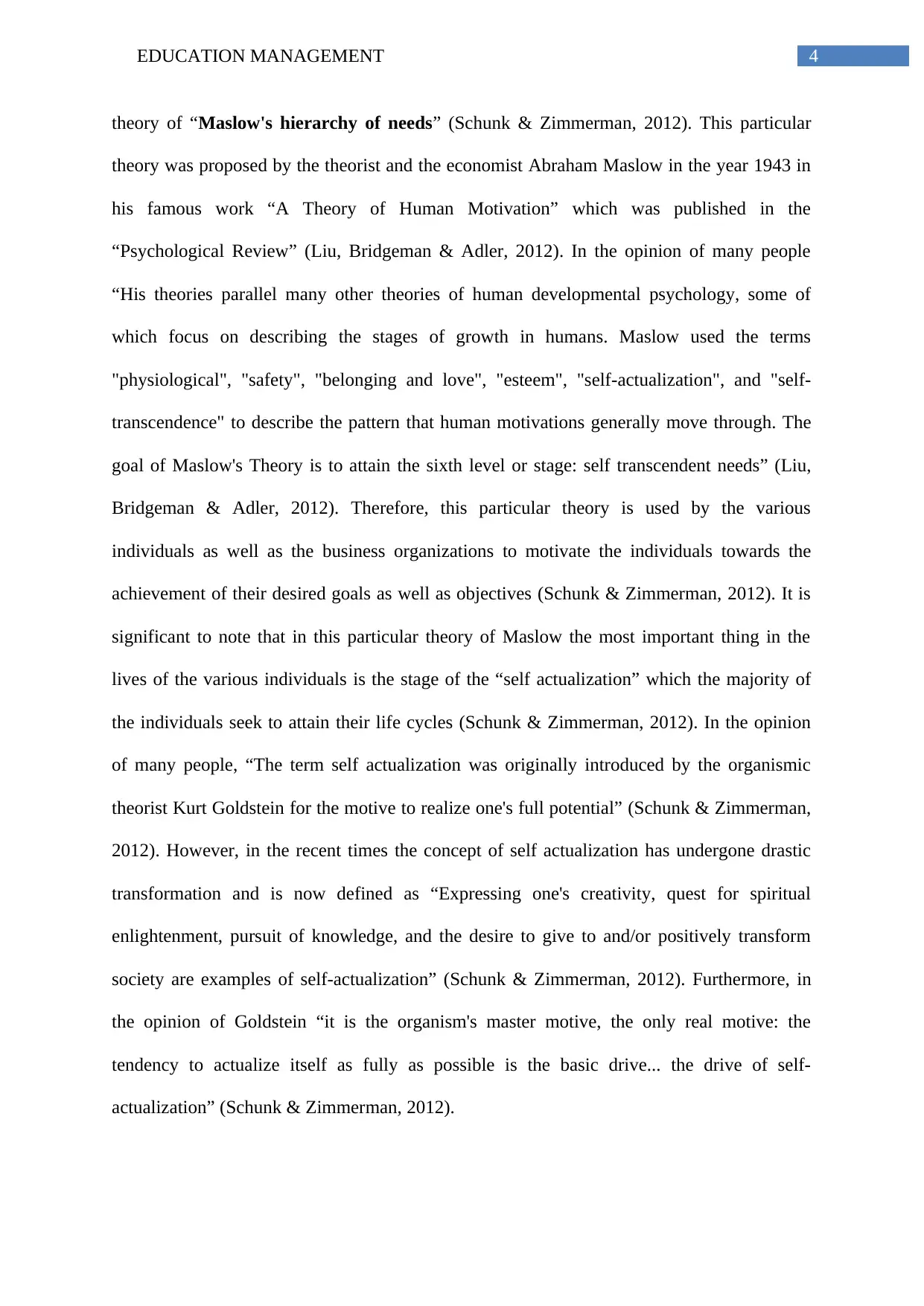
4EDUCATION MANAGEMENT
theory of “Maslow's hierarchy of needs” (Schunk & Zimmerman, 2012). This particular
theory was proposed by the theorist and the economist Abraham Maslow in the year 1943 in
his famous work “A Theory of Human Motivation” which was published in the
“Psychological Review” (Liu, Bridgeman & Adler, 2012). In the opinion of many people
“His theories parallel many other theories of human developmental psychology, some of
which focus on describing the stages of growth in humans. Maslow used the terms
"physiological", "safety", "belonging and love", "esteem", "self-actualization", and "self-
transcendence" to describe the pattern that human motivations generally move through. The
goal of Maslow's Theory is to attain the sixth level or stage: self transcendent needs” (Liu,
Bridgeman & Adler, 2012). Therefore, this particular theory is used by the various
individuals as well as the business organizations to motivate the individuals towards the
achievement of their desired goals as well as objectives (Schunk & Zimmerman, 2012). It is
significant to note that in this particular theory of Maslow the most important thing in the
lives of the various individuals is the stage of the “self actualization” which the majority of
the individuals seek to attain their life cycles (Schunk & Zimmerman, 2012). In the opinion
of many people, “The term self actualization was originally introduced by the organismic
theorist Kurt Goldstein for the motive to realize one's full potential” (Schunk & Zimmerman,
2012). However, in the recent times the concept of self actualization has undergone drastic
transformation and is now defined as “Expressing one's creativity, quest for spiritual
enlightenment, pursuit of knowledge, and the desire to give to and/or positively transform
society are examples of self-actualization” (Schunk & Zimmerman, 2012). Furthermore, in
the opinion of Goldstein “it is the organism's master motive, the only real motive: the
tendency to actualize itself as fully as possible is the basic drive... the drive of self-
actualization” (Schunk & Zimmerman, 2012).
theory of “Maslow's hierarchy of needs” (Schunk & Zimmerman, 2012). This particular
theory was proposed by the theorist and the economist Abraham Maslow in the year 1943 in
his famous work “A Theory of Human Motivation” which was published in the
“Psychological Review” (Liu, Bridgeman & Adler, 2012). In the opinion of many people
“His theories parallel many other theories of human developmental psychology, some of
which focus on describing the stages of growth in humans. Maslow used the terms
"physiological", "safety", "belonging and love", "esteem", "self-actualization", and "self-
transcendence" to describe the pattern that human motivations generally move through. The
goal of Maslow's Theory is to attain the sixth level or stage: self transcendent needs” (Liu,
Bridgeman & Adler, 2012). Therefore, this particular theory is used by the various
individuals as well as the business organizations to motivate the individuals towards the
achievement of their desired goals as well as objectives (Schunk & Zimmerman, 2012). It is
significant to note that in this particular theory of Maslow the most important thing in the
lives of the various individuals is the stage of the “self actualization” which the majority of
the individuals seek to attain their life cycles (Schunk & Zimmerman, 2012). In the opinion
of many people, “The term self actualization was originally introduced by the organismic
theorist Kurt Goldstein for the motive to realize one's full potential” (Schunk & Zimmerman,
2012). However, in the recent times the concept of self actualization has undergone drastic
transformation and is now defined as “Expressing one's creativity, quest for spiritual
enlightenment, pursuit of knowledge, and the desire to give to and/or positively transform
society are examples of self-actualization” (Schunk & Zimmerman, 2012). Furthermore, in
the opinion of Goldstein “it is the organism's master motive, the only real motive: the
tendency to actualize itself as fully as possible is the basic drive... the drive of self-
actualization” (Schunk & Zimmerman, 2012).
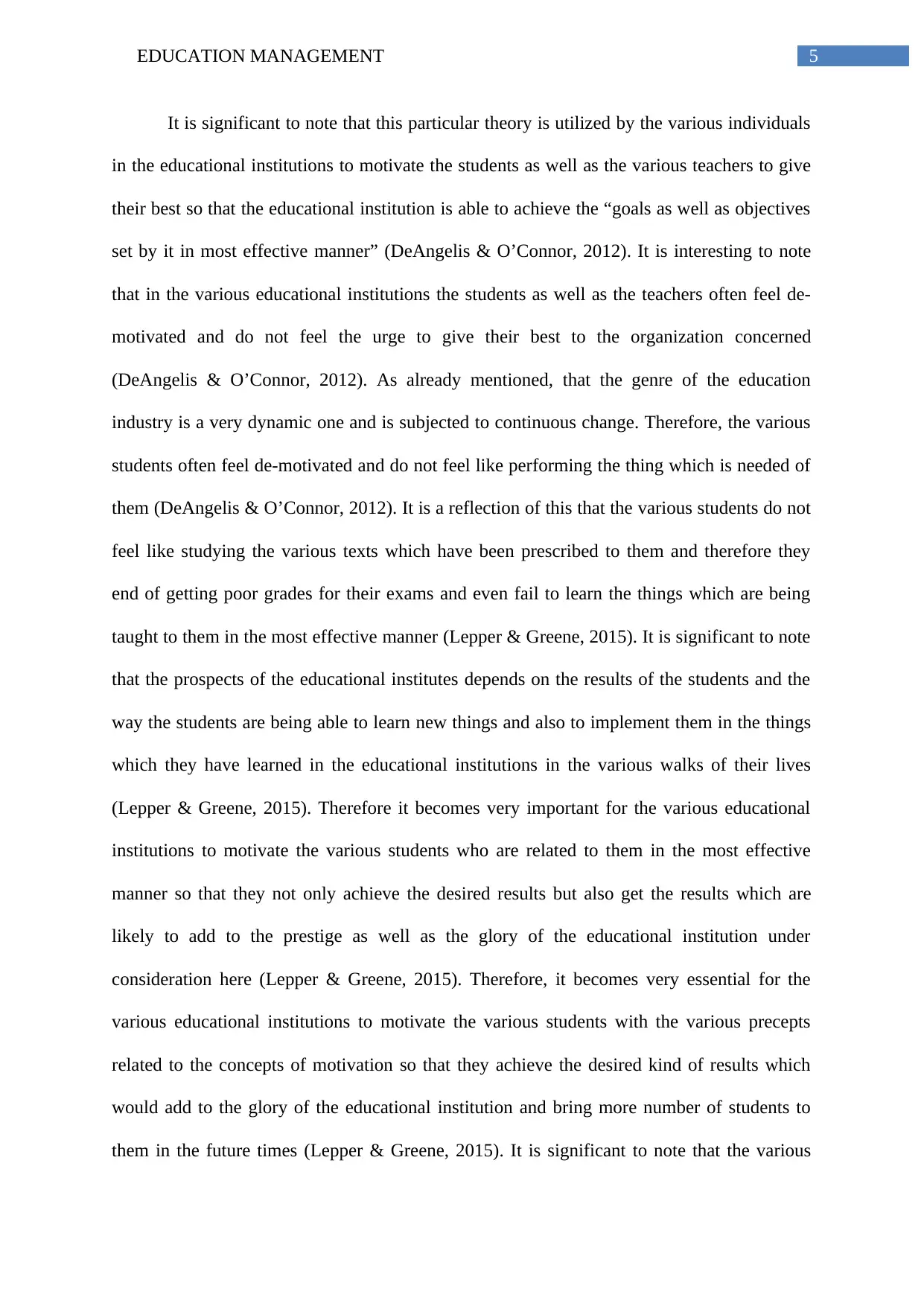
5EDUCATION MANAGEMENT
It is significant to note that this particular theory is utilized by the various individuals
in the educational institutions to motivate the students as well as the various teachers to give
their best so that the educational institution is able to achieve the “goals as well as objectives
set by it in most effective manner” (DeAngelis & O’Connor, 2012). It is interesting to note
that in the various educational institutions the students as well as the teachers often feel de-
motivated and do not feel the urge to give their best to the organization concerned
(DeAngelis & O’Connor, 2012). As already mentioned, that the genre of the education
industry is a very dynamic one and is subjected to continuous change. Therefore, the various
students often feel de-motivated and do not feel like performing the thing which is needed of
them (DeAngelis & O’Connor, 2012). It is a reflection of this that the various students do not
feel like studying the various texts which have been prescribed to them and therefore they
end of getting poor grades for their exams and even fail to learn the things which are being
taught to them in the most effective manner (Lepper & Greene, 2015). It is significant to note
that the prospects of the educational institutes depends on the results of the students and the
way the students are being able to learn new things and also to implement them in the things
which they have learned in the educational institutions in the various walks of their lives
(Lepper & Greene, 2015). Therefore it becomes very important for the various educational
institutions to motivate the various students who are related to them in the most effective
manner so that they not only achieve the desired results but also get the results which are
likely to add to the prestige as well as the glory of the educational institution under
consideration here (Lepper & Greene, 2015). Therefore, it becomes very essential for the
various educational institutions to motivate the various students with the various precepts
related to the concepts of motivation so that they achieve the desired kind of results which
would add to the glory of the educational institution and bring more number of students to
them in the future times (Lepper & Greene, 2015). It is significant to note that the various
It is significant to note that this particular theory is utilized by the various individuals
in the educational institutions to motivate the students as well as the various teachers to give
their best so that the educational institution is able to achieve the “goals as well as objectives
set by it in most effective manner” (DeAngelis & O’Connor, 2012). It is interesting to note
that in the various educational institutions the students as well as the teachers often feel de-
motivated and do not feel the urge to give their best to the organization concerned
(DeAngelis & O’Connor, 2012). As already mentioned, that the genre of the education
industry is a very dynamic one and is subjected to continuous change. Therefore, the various
students often feel de-motivated and do not feel like performing the thing which is needed of
them (DeAngelis & O’Connor, 2012). It is a reflection of this that the various students do not
feel like studying the various texts which have been prescribed to them and therefore they
end of getting poor grades for their exams and even fail to learn the things which are being
taught to them in the most effective manner (Lepper & Greene, 2015). It is significant to note
that the prospects of the educational institutes depends on the results of the students and the
way the students are being able to learn new things and also to implement them in the things
which they have learned in the educational institutions in the various walks of their lives
(Lepper & Greene, 2015). Therefore it becomes very important for the various educational
institutions to motivate the various students who are related to them in the most effective
manner so that they not only achieve the desired results but also get the results which are
likely to add to the prestige as well as the glory of the educational institution under
consideration here (Lepper & Greene, 2015). Therefore, it becomes very essential for the
various educational institutions to motivate the various students with the various precepts
related to the concepts of motivation so that they achieve the desired kind of results which
would add to the glory of the educational institution and bring more number of students to
them in the future times (Lepper & Greene, 2015). It is significant to note that the various
⊘ This is a preview!⊘
Do you want full access?
Subscribe today to unlock all pages.

Trusted by 1+ million students worldwide
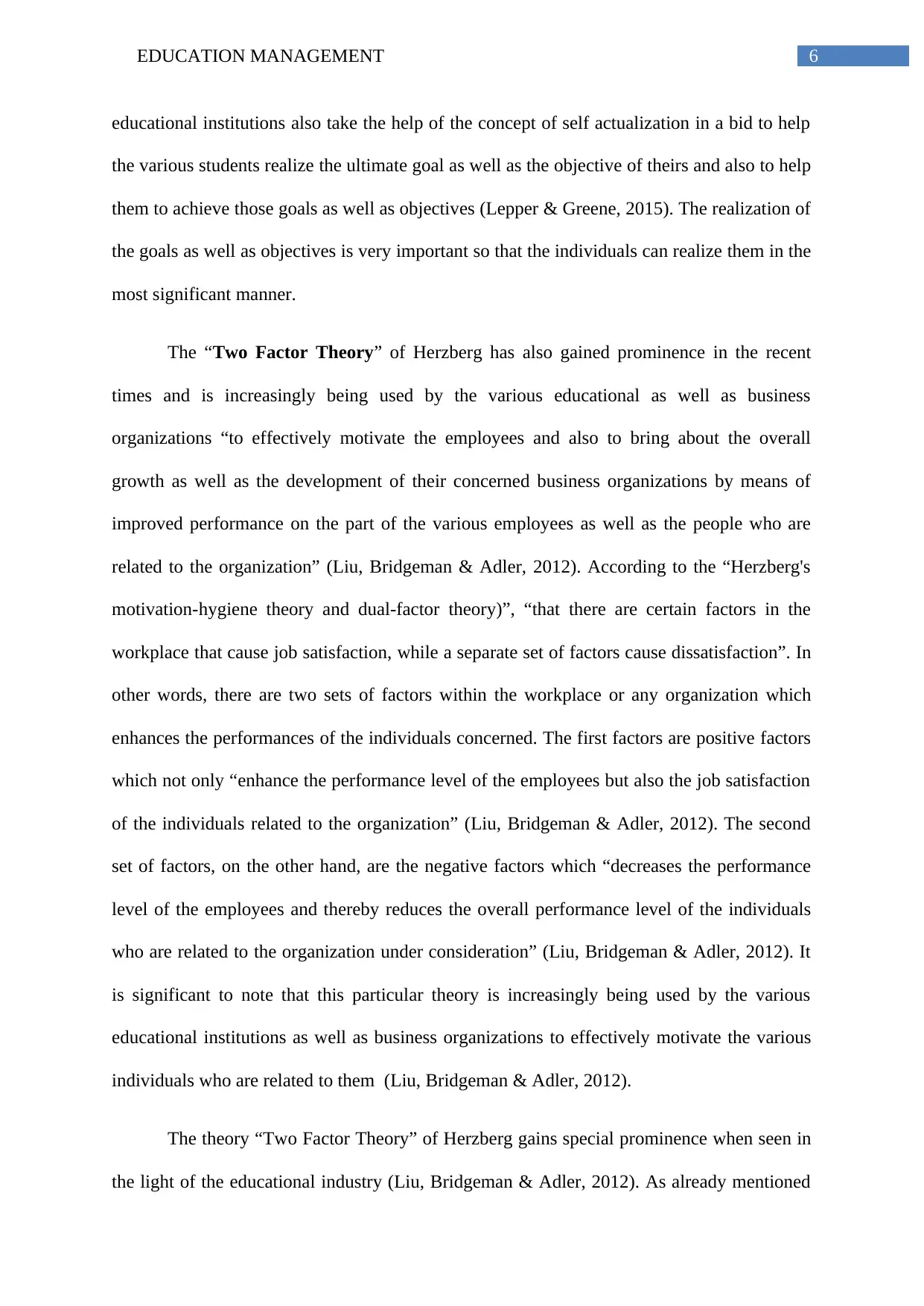
6EDUCATION MANAGEMENT
educational institutions also take the help of the concept of self actualization in a bid to help
the various students realize the ultimate goal as well as the objective of theirs and also to help
them to achieve those goals as well as objectives (Lepper & Greene, 2015). The realization of
the goals as well as objectives is very important so that the individuals can realize them in the
most significant manner.
The “Two Factor Theory” of Herzberg has also gained prominence in the recent
times and is increasingly being used by the various educational as well as business
organizations “to effectively motivate the employees and also to bring about the overall
growth as well as the development of their concerned business organizations by means of
improved performance on the part of the various employees as well as the people who are
related to the organization” (Liu, Bridgeman & Adler, 2012). According to the “Herzberg's
motivation-hygiene theory and dual-factor theory)”, “that there are certain factors in the
workplace that cause job satisfaction, while a separate set of factors cause dissatisfaction”. In
other words, there are two sets of factors within the workplace or any organization which
enhances the performances of the individuals concerned. The first factors are positive factors
which not only “enhance the performance level of the employees but also the job satisfaction
of the individuals related to the organization” (Liu, Bridgeman & Adler, 2012). The second
set of factors, on the other hand, are the negative factors which “decreases the performance
level of the employees and thereby reduces the overall performance level of the individuals
who are related to the organization under consideration” (Liu, Bridgeman & Adler, 2012). It
is significant to note that this particular theory is increasingly being used by the various
educational institutions as well as business organizations to effectively motivate the various
individuals who are related to them (Liu, Bridgeman & Adler, 2012).
The theory “Two Factor Theory” of Herzberg gains special prominence when seen in
the light of the educational industry (Liu, Bridgeman & Adler, 2012). As already mentioned
educational institutions also take the help of the concept of self actualization in a bid to help
the various students realize the ultimate goal as well as the objective of theirs and also to help
them to achieve those goals as well as objectives (Lepper & Greene, 2015). The realization of
the goals as well as objectives is very important so that the individuals can realize them in the
most significant manner.
The “Two Factor Theory” of Herzberg has also gained prominence in the recent
times and is increasingly being used by the various educational as well as business
organizations “to effectively motivate the employees and also to bring about the overall
growth as well as the development of their concerned business organizations by means of
improved performance on the part of the various employees as well as the people who are
related to the organization” (Liu, Bridgeman & Adler, 2012). According to the “Herzberg's
motivation-hygiene theory and dual-factor theory)”, “that there are certain factors in the
workplace that cause job satisfaction, while a separate set of factors cause dissatisfaction”. In
other words, there are two sets of factors within the workplace or any organization which
enhances the performances of the individuals concerned. The first factors are positive factors
which not only “enhance the performance level of the employees but also the job satisfaction
of the individuals related to the organization” (Liu, Bridgeman & Adler, 2012). The second
set of factors, on the other hand, are the negative factors which “decreases the performance
level of the employees and thereby reduces the overall performance level of the individuals
who are related to the organization under consideration” (Liu, Bridgeman & Adler, 2012). It
is significant to note that this particular theory is increasingly being used by the various
educational institutions as well as business organizations to effectively motivate the various
individuals who are related to them (Liu, Bridgeman & Adler, 2012).
The theory “Two Factor Theory” of Herzberg gains special prominence when seen in
the light of the educational industry (Liu, Bridgeman & Adler, 2012). As already mentioned
Paraphrase This Document
Need a fresh take? Get an instant paraphrase of this document with our AI Paraphraser
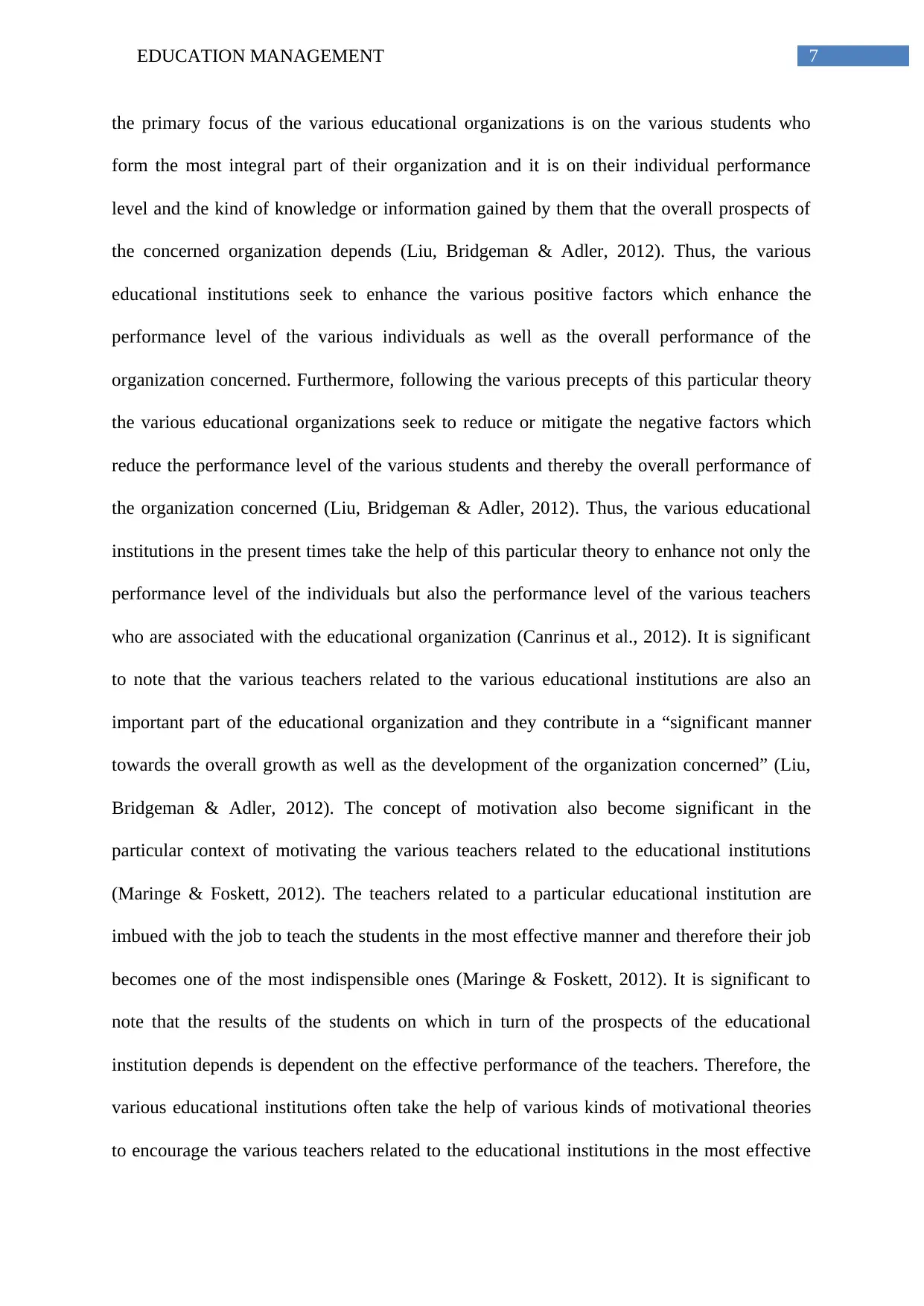
7EDUCATION MANAGEMENT
the primary focus of the various educational organizations is on the various students who
form the most integral part of their organization and it is on their individual performance
level and the kind of knowledge or information gained by them that the overall prospects of
the concerned organization depends (Liu, Bridgeman & Adler, 2012). Thus, the various
educational institutions seek to enhance the various positive factors which enhance the
performance level of the various individuals as well as the overall performance of the
organization concerned. Furthermore, following the various precepts of this particular theory
the various educational organizations seek to reduce or mitigate the negative factors which
reduce the performance level of the various students and thereby the overall performance of
the organization concerned (Liu, Bridgeman & Adler, 2012). Thus, the various educational
institutions in the present times take the help of this particular theory to enhance not only the
performance level of the individuals but also the performance level of the various teachers
who are associated with the educational organization (Canrinus et al., 2012). It is significant
to note that the various teachers related to the various educational institutions are also an
important part of the educational organization and they contribute in a “significant manner
towards the overall growth as well as the development of the organization concerned” (Liu,
Bridgeman & Adler, 2012). The concept of motivation also become significant in the
particular context of motivating the various teachers related to the educational institutions
(Maringe & Foskett, 2012). The teachers related to a particular educational institution are
imbued with the job to teach the students in the most effective manner and therefore their job
becomes one of the most indispensible ones (Maringe & Foskett, 2012). It is significant to
note that the results of the students on which in turn of the prospects of the educational
institution depends is dependent on the effective performance of the teachers. Therefore, the
various educational institutions often take the help of various kinds of motivational theories
to encourage the various teachers related to the educational institutions in the most effective
the primary focus of the various educational organizations is on the various students who
form the most integral part of their organization and it is on their individual performance
level and the kind of knowledge or information gained by them that the overall prospects of
the concerned organization depends (Liu, Bridgeman & Adler, 2012). Thus, the various
educational institutions seek to enhance the various positive factors which enhance the
performance level of the various individuals as well as the overall performance of the
organization concerned. Furthermore, following the various precepts of this particular theory
the various educational organizations seek to reduce or mitigate the negative factors which
reduce the performance level of the various students and thereby the overall performance of
the organization concerned (Liu, Bridgeman & Adler, 2012). Thus, the various educational
institutions in the present times take the help of this particular theory to enhance not only the
performance level of the individuals but also the performance level of the various teachers
who are associated with the educational organization (Canrinus et al., 2012). It is significant
to note that the various teachers related to the various educational institutions are also an
important part of the educational organization and they contribute in a “significant manner
towards the overall growth as well as the development of the organization concerned” (Liu,
Bridgeman & Adler, 2012). The concept of motivation also become significant in the
particular context of motivating the various teachers related to the educational institutions
(Maringe & Foskett, 2012). The teachers related to a particular educational institution are
imbued with the job to teach the students in the most effective manner and therefore their job
becomes one of the most indispensible ones (Maringe & Foskett, 2012). It is significant to
note that the results of the students on which in turn of the prospects of the educational
institution depends is dependent on the effective performance of the teachers. Therefore, the
various educational institutions often take the help of various kinds of motivational theories
to encourage the various teachers related to the educational institutions in the most effective
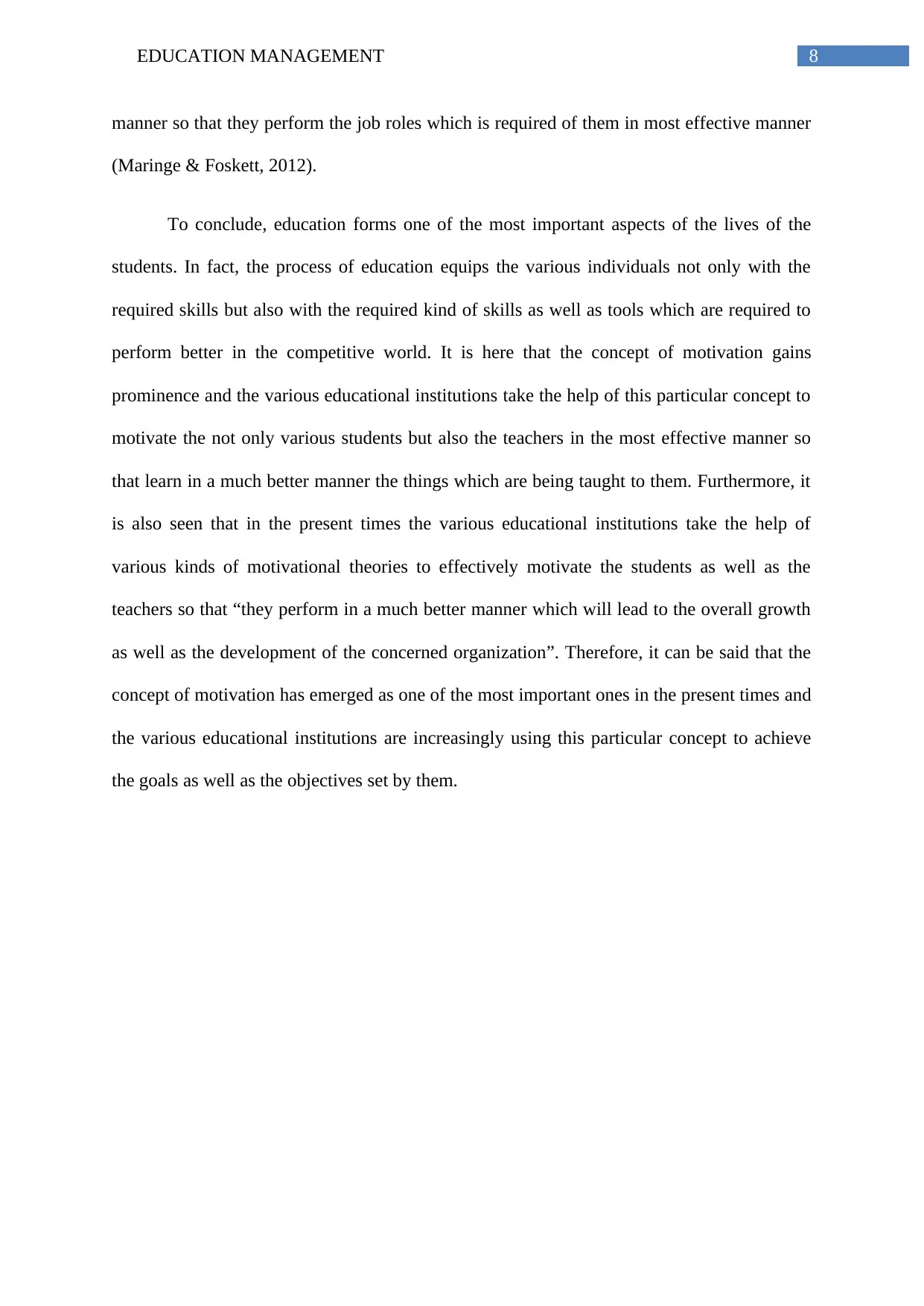
8EDUCATION MANAGEMENT
manner so that they perform the job roles which is required of them in most effective manner
(Maringe & Foskett, 2012).
To conclude, education forms one of the most important aspects of the lives of the
students. In fact, the process of education equips the various individuals not only with the
required skills but also with the required kind of skills as well as tools which are required to
perform better in the competitive world. It is here that the concept of motivation gains
prominence and the various educational institutions take the help of this particular concept to
motivate the not only various students but also the teachers in the most effective manner so
that learn in a much better manner the things which are being taught to them. Furthermore, it
is also seen that in the present times the various educational institutions take the help of
various kinds of motivational theories to effectively motivate the students as well as the
teachers so that “they perform in a much better manner which will lead to the overall growth
as well as the development of the concerned organization”. Therefore, it can be said that the
concept of motivation has emerged as one of the most important ones in the present times and
the various educational institutions are increasingly using this particular concept to achieve
the goals as well as the objectives set by them.
manner so that they perform the job roles which is required of them in most effective manner
(Maringe & Foskett, 2012).
To conclude, education forms one of the most important aspects of the lives of the
students. In fact, the process of education equips the various individuals not only with the
required skills but also with the required kind of skills as well as tools which are required to
perform better in the competitive world. It is here that the concept of motivation gains
prominence and the various educational institutions take the help of this particular concept to
motivate the not only various students but also the teachers in the most effective manner so
that learn in a much better manner the things which are being taught to them. Furthermore, it
is also seen that in the present times the various educational institutions take the help of
various kinds of motivational theories to effectively motivate the students as well as the
teachers so that “they perform in a much better manner which will lead to the overall growth
as well as the development of the concerned organization”. Therefore, it can be said that the
concept of motivation has emerged as one of the most important ones in the present times and
the various educational institutions are increasingly using this particular concept to achieve
the goals as well as the objectives set by them.
⊘ This is a preview!⊘
Do you want full access?
Subscribe today to unlock all pages.

Trusted by 1+ million students worldwide
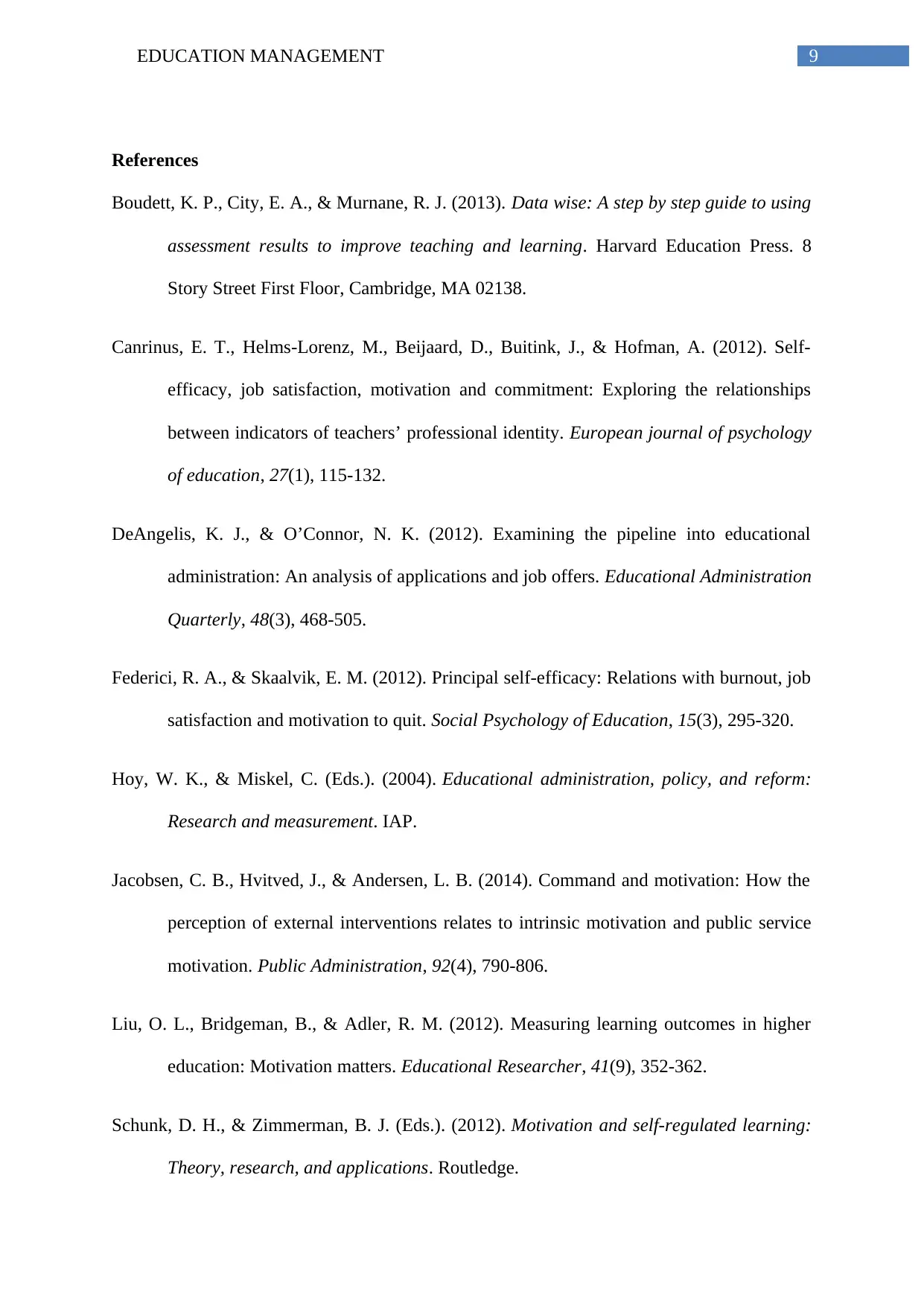
9EDUCATION MANAGEMENT
References
Boudett, K. P., City, E. A., & Murnane, R. J. (2013). Data wise: A step by step guide to using
assessment results to improve teaching and learning. Harvard Education Press. 8
Story Street First Floor, Cambridge, MA 02138.
Canrinus, E. T., Helms-Lorenz, M., Beijaard, D., Buitink, J., & Hofman, A. (2012). Self-
efficacy, job satisfaction, motivation and commitment: Exploring the relationships
between indicators of teachers’ professional identity. European journal of psychology
of education, 27(1), 115-132.
DeAngelis, K. J., & O’Connor, N. K. (2012). Examining the pipeline into educational
administration: An analysis of applications and job offers. Educational Administration
Quarterly, 48(3), 468-505.
Federici, R. A., & Skaalvik, E. M. (2012). Principal self-efficacy: Relations with burnout, job
satisfaction and motivation to quit. Social Psychology of Education, 15(3), 295-320.
Hoy, W. K., & Miskel, C. (Eds.). (2004). Educational administration, policy, and reform:
Research and measurement. IAP.
Jacobsen, C. B., Hvitved, J., & Andersen, L. B. (2014). Command and motivation: How the
perception of external interventions relates to intrinsic motivation and public service
motivation. Public Administration, 92(4), 790-806.
Liu, O. L., Bridgeman, B., & Adler, R. M. (2012). Measuring learning outcomes in higher
education: Motivation matters. Educational Researcher, 41(9), 352-362.
Schunk, D. H., & Zimmerman, B. J. (Eds.). (2012). Motivation and self-regulated learning:
Theory, research, and applications. Routledge.
References
Boudett, K. P., City, E. A., & Murnane, R. J. (2013). Data wise: A step by step guide to using
assessment results to improve teaching and learning. Harvard Education Press. 8
Story Street First Floor, Cambridge, MA 02138.
Canrinus, E. T., Helms-Lorenz, M., Beijaard, D., Buitink, J., & Hofman, A. (2012). Self-
efficacy, job satisfaction, motivation and commitment: Exploring the relationships
between indicators of teachers’ professional identity. European journal of psychology
of education, 27(1), 115-132.
DeAngelis, K. J., & O’Connor, N. K. (2012). Examining the pipeline into educational
administration: An analysis of applications and job offers. Educational Administration
Quarterly, 48(3), 468-505.
Federici, R. A., & Skaalvik, E. M. (2012). Principal self-efficacy: Relations with burnout, job
satisfaction and motivation to quit. Social Psychology of Education, 15(3), 295-320.
Hoy, W. K., & Miskel, C. (Eds.). (2004). Educational administration, policy, and reform:
Research and measurement. IAP.
Jacobsen, C. B., Hvitved, J., & Andersen, L. B. (2014). Command and motivation: How the
perception of external interventions relates to intrinsic motivation and public service
motivation. Public Administration, 92(4), 790-806.
Liu, O. L., Bridgeman, B., & Adler, R. M. (2012). Measuring learning outcomes in higher
education: Motivation matters. Educational Researcher, 41(9), 352-362.
Schunk, D. H., & Zimmerman, B. J. (Eds.). (2012). Motivation and self-regulated learning:
Theory, research, and applications. Routledge.
1 out of 10
Your All-in-One AI-Powered Toolkit for Academic Success.
+13062052269
info@desklib.com
Available 24*7 on WhatsApp / Email
![[object Object]](/_next/static/media/star-bottom.7253800d.svg)
Unlock your academic potential
Copyright © 2020–2025 A2Z Services. All Rights Reserved. Developed and managed by ZUCOL.
